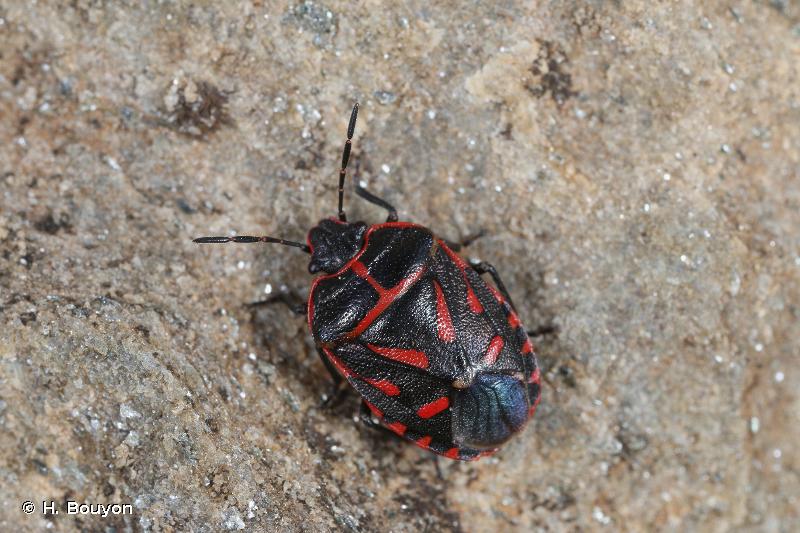
cd_nom

| Author : F. Chevaillot |
 |
To get the picture, please visit:
Fred CHEVAILLOT
Moulin de Castor
La Maynobe
12550 COUPIAC
06 51 19 18 32
09 88 28 31 26
www.insecte.org
email : fred.chevaillot@wanadoo.fr
Any reuse of one or more photographs on this site is subject to an authorization request from the author.
Link to the Code of Intellectual Property (Legifrance)

| Author : H. Bouyon |
 |
To get the picture, please visit:
Hervé BOUYON
email : herve.bouyon@wanadoo.fr
Any reuse of one or more photographs on this site is subject to an authorization request from the author.
Link to the Code of Intellectual Property (Legifrance)
Taille : 7 – 8,5 mm
Diagnose :
Punaise de coloration générale vert sombre métallisé, bariolée de taches claires rouges. Corie (partie sclérifiée de l'aile antérieure) dont la partie centrale (mésocorie) porte 2 taches rouges, et dont la partie externe latérale (exocorie) est rouge dans le tiers basal et sombre jusqu'à l'apex. Bandes latérales rouges du scutellum jamais confluentes. Pronotum entouré par un fin liseré rouge, avec une ligne médiane rouge formant 2 fenêtres sombres. Ce liseré rouge a la même largeur tout autour du pronotum.
Détermination : Moyennement difficile.
Espèces proches :
Très proche d'Eurydema fieberi qui est plus claire, qui a le liseré des bords latéraux et du bord postérieur du pronotum plus large que celui du bord antérieur, et qui est plus massive qu'E. rotundicollis.
Période d'observation :
Observée de mai à août, mais on ne dispose pas de suffisamment d'observations pour définir une période d'observation précise.
Biologie-éthologie :
Elle ponctionne des crucifères jaunes d'altitude, notamment la biscutelle commune, le sisymbre d'Autriche, ou l'hugueninie à feuilles de tanaisie, et se réfugie parfois sous les pierres proches.
Biogéographie et écologie :
Espèce européenne et alpine, mais ne dépassant pas 49° de latitude nord et localisée aux Alpes, Carpates, Apennins, Alpes dinariques, Monts du Pinde, massifs montagneux du système central ibérique, et Pyrénées. Elle vit entre 1 500 et 2 400 m, dans les milieux rocailleux d'altitude : pierriers, pelouses et prairies des étages subalpin et alpin, friches et milieux rudéraux d'altitude, bord des pistes de skis, couloirs d'avalanches, lisières forestières de mélèzes, bords des torrents. C'est une espèce rare, mais on la trouve parfois par petits groupes d'individus.
Roland Lupoli (),2020
Continental
Metropolitan France
Overseas
Marine
Metropolitan France
Overseas
The map presents a summary at the 10 x 10 km grid of the observation data for the species transmitted to the SINP. These data have been subjected to validation filters.
The map presents a reference distribution layer of the species at the scale of departments and marine sectors. The presence and absence data were established by expertise within a network of partners. This reference distribution is used in the validation process of the SINP data at the INPN level.
Corresponds to a report on the basis of at least one observation proved within a period of 10 years (20 years for little-known invertebrates) preceding the year and no presumption of extinction since obtaining the last data nor doubt on reproductive and implemented nature of this population. For migratory species, the presence indicated concerns areas of reproduction.
This status is based on one or more of the following criteria:
This point covers the absence, more difficult by nature to demonstrate than presence. This status is based on one or more of the following criteria:
This status must be assigned to a department in which the presence of the species is casual.
Particular case of absence due to a proven extinction less than a half century ago (older disappearances are treated as "no probable or definite").
In the state of knowledge, we can not comment on the presence or absence in the current department. This is the default status when not comprised in one of the previous categories or whenever there is doubt.
The map shows the global distribution of the species based on GBIF data (Global Biodiversity Information Facility).
